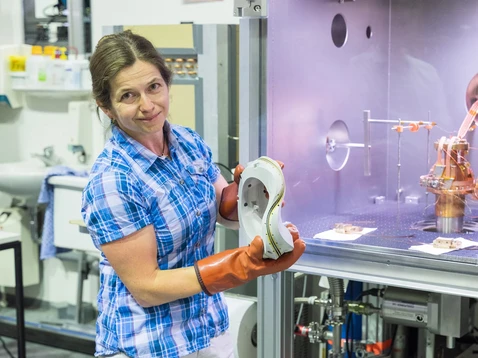News
Nuclear fusion research using neutrons from FRM II
Wissenschaft, Industrie, Pressemitteilung |

Nuclear fusion research aims to harness the energy released when atomic nuclei fuse. Two main approaches are currently being pursued: magnetic fusion and inertial confinement fusion. Fusion power plants are still in the research and development stage, but they could potentially help meet humanity’s growing energy needs in the future.
“HTS4Fusion is a valuable collaboration between industry and science to better understand high-temperature superconductors using fission neutrons and optimize them for future applications. In this way, fission and fusion work together to advance the technical utilization of nuclear fusion,” says Dr. Christian Reiter, head of the project at FRM II.
What do neutrons do to high-temperature superconductors?
In order to magnetically confine the plasma in a fusion reactor, coils based on superconductors are required, as these conduct electricity without resistance. HTS offer interesting advantages in this respect: for example, less effort is needed for cooling. In addition, higher magnetic field strengths can be achieved, enabling a more compact power plant design.
However, little research has been done so far on how such novel superconductors behave under high neutron bombardment, which is to be expected inside a fusion reactor. Furthermore, not only must the properties of the individual coated conductors be investigated, but also the interaction of these properties with the design of the electromagnetic coils. “Even with flat coils, these are topics of intensive research. And how the non-planarity of stellarator coils affects the results is another twist,” adds Dr. Eve Stenson, who oversees HTS4Fusion at the IPP.
Dr. Werner Prusseit from THEVA adds: “We are the only manufacturer of high-temperature superconductor tapes in Europe. The HTS4Fusion project aims to take a decisive step towards large-scale production of HTS to be able to manufacture the quantities required for fusion power plants.”
With the help of fast neutrons generated at FRM II, research will be conducted into how the components’ superconducting, metallurgical, and mechanical properties change under neutron bombardment. “We can use neutrons at FRM II to better understand materials for fusion research,” says Dr. Christian Reiter.
With these findings, the HTS can then be optimized for later applications in potential fusion reactors. At FRM II, both the fast fission neutrons for irradiating the materials and the scientific neutron instruments for characterizing the changed properties will be used.
The BMFTR is providing 1.1 million euros for the subproject at FRM II until the end of 2027.
Further information:
News from the IPP about HTS4Fusion
Max Planck Institute for Plasma Physics
MLZ conference “Neutrons for Fusion and Nuclear Applications” 28.07.2025 – 31.07.2025
Contact:
Dr. Christian Reiter
christian.reiter(at)frm2.tum.de
+49 89 289 13906
